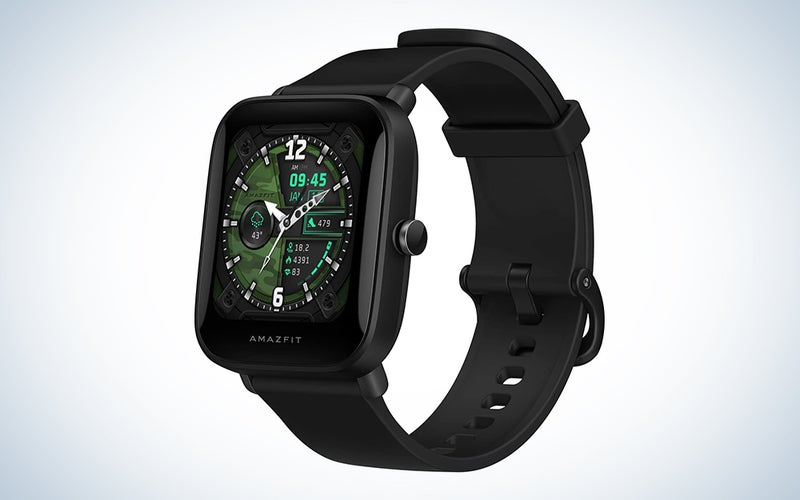Amazfit Bip U Pro review: A budget fitness tracker that may amaze you
This Amazfit Bip U can help monitor your health like a pro.
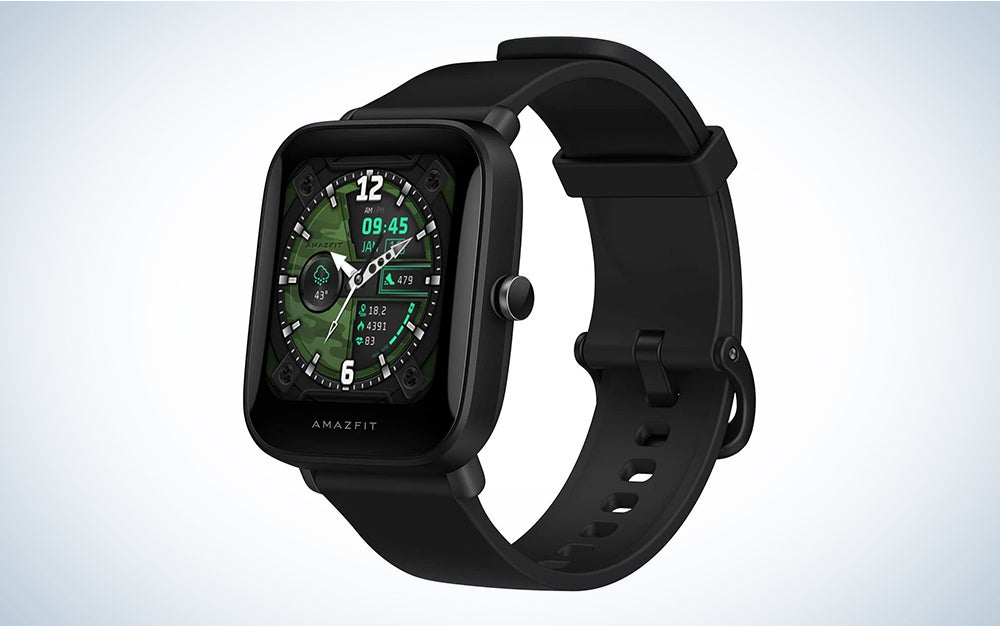
We may earn revenue from the products available on this page and participate in affiliate programs. Learn more ›
Even before the pandemic, telehealth was on the rise. Now, after more than a year of lockdowns, doctors and researchers suggest virtual healthcare will only continue to grow. Smartwatches and other devices that track basic health data (like breathing and heart rate) will play an essential role in expanding virtual healthcare. If devices can reliably supply doctors with vital signs and other health markers, they could reduce the frequency of in-person visits.
So if smartwatches and fitness trackers are critical to virtual healthcare, budget health trackers like the Amazfit Bip U Pro are critical to scalability. At around $70, this budget smartwatch is the kind of well-equipped, affordable fitness tracker that could be a big part of how more people monitor their health.
The Amazfit Bip U Pro fitness tracker sits above the Bip U. The Pro model adds Alexa voice support, GPS, and a compass. Combined with onboard blood oxygen and heart rate monitors, it can track up to 60 different activities, including running, rowing, or rope skipping. But it’ll also keep you up-to-date on your baseline markers, by automatically measuring your heart rate, steps, stress, and sleep. When the battery is running low, you can pare it back to just the vitals.
On top of the best fitness tracker functions, the Amazfit Bip U Pro offers handy smartwatch features, like alert notifications and music controls. I tested it for roughly two weeks while caring for my newborn son. Overall, I found that the budget smartwatch kept me updated on the information I wanted and needed—from news headlines and sports scores to my daily step total and sleep score.
Design
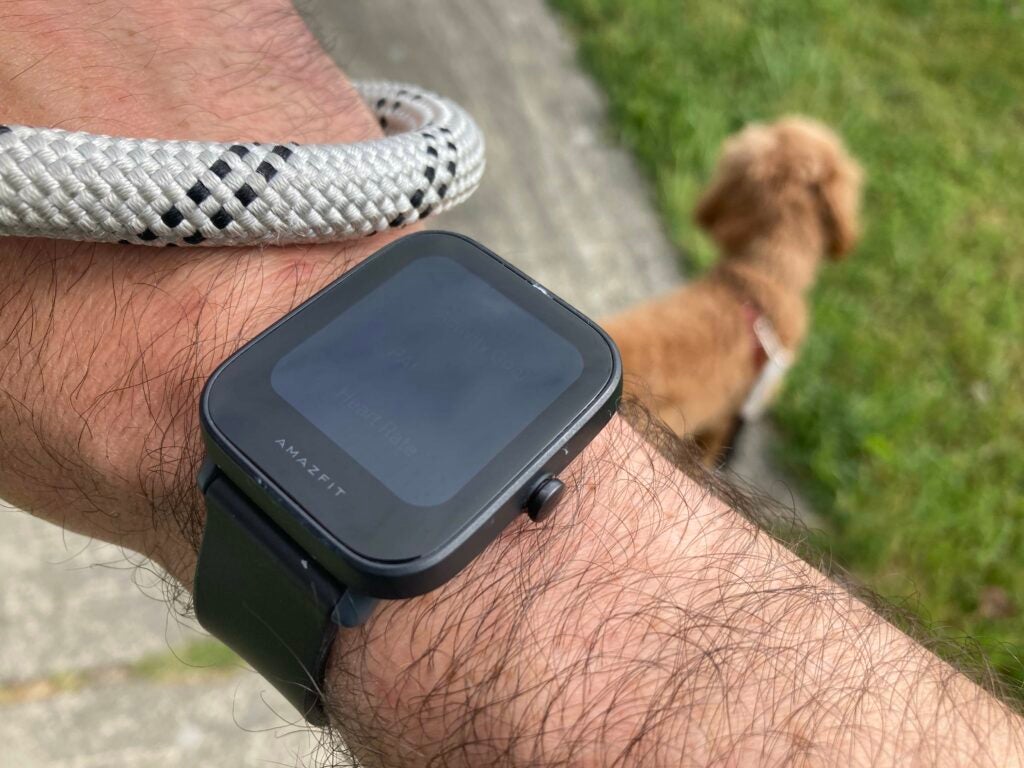
Given the Amazfit Bip U Pro watch’s shape and minimalist look, onlookers will likely mistake it for an Apple Watch. Underneath the face, however, the Amazfit smartwatch offers several features that are surprising for a budget smartwatch.
Since the Amazfit watch’s primary function is as a health monitor, let’s start with the built-in tracking. On the back, you’ll find four dots that are capable of measuring a monumental amount of data. The BioTracker 2 PPG optical sensor measures your heart rate around the clock. It can also read your blood oxygen level and count your breaths each second, giving you a real-time snapshot of your well-being.
Meanwhile, an accelerometer measures movement to track your motion and tabulate your steps. The built-in gyroscope records your orientation (among other variables) to help it identify specific movements. For instance, it knows when you raise your wrist to wake it up, or when you are tossing and turning during your sleep. A geomagnetic sensor rounds out the instrument array to determine your Amazfit Bip Pro U’s position relative to the North Pole.
The LCD color touchscreen displaying all this data measures 1.43 inches and boasts a resolution of 320×302; by comparison, the Apple Watch Series 6 has a 1.57-inch display with a resolution of 394×324. The Amazfit is pretty close for a budget smartwatch. Like the Apple Watch, the Amazfit Bip U Pro is a water-resistant 5ATM-rated smartwatch and can survive in water up to 50 meters deep.
Press the button on the side to wake up the watch or toggle between screens. Aside from the main face with customizable displays available via the Zepp app, you can access a list of functions—from your activity goals to your alarms.
The included silicone wristband is where this Amazfit smartwatch begins to reveal itself as a budget smartwatch. The replaceable 20mm band looks and feels cheap, but, at least initially, it’s surprisingly comfortable. There are 14 holes, so you can get the sizing exactly right, and at 31 grams the watch is as light as other budget fitness trackers. (The Fitbit Inspire 2 clocks in at 30 grams.) In fact, when I first put on the Amazfit Bip U Pro, I was surprised at how little I noticed it on my wrist. However, the cheap band traps moisture, so, over the course of several workouts and showers, I developed a red mark and dry skin under the watch. If you don’t shower with the watch and are careful to dry it after a workout or hand wash, you’ll likely be fine—but that’s a notable drawback for a fitness-oriented device.
The 230 mAh battery is slated to last nine days and mostly lives up to that billing. I ran it down to 22 percent in six days and charged it back to full power with the USB-powered magnetic charging base in less than two hours.
Setting up the Amazfit Bip U Pro
Setting up the Amazfit Bip U Pro was a snap. When I took it out of the box and turned on the watch, the face displayed a QR code that I captured with my iPhone’s camera. The Zepp app automatically began downloading (you can also download it directly from your device’s app store), and then I synced my phone and watch over Bluetooth in roughly eight minutes. The watch is compatible with Android 5.0 and above and iOS 10.0 and above (I have an iPhone SE, hardly top-of-the-line).
Once I had the devices linked, I used the Zepp app to set my fitness goals and input my health data. I also chose which alerts I wanted buzzing my phone. I was fully up and running in 20 minutes. On the downside, the app and the phone needed to resync every time I opened the Zepp app. This process was too often frustratingly slow, even when I connected to my home’s fiber optic-powered wireless.
Key features of the Amazfit Bip U Pro
For me, detailed health monitoring made the Amazfit Bip U Pro stand apart from other budget fitness trackers. It can monitor your heart rate 24/7, measure your blood oxygen, your stress, your breathing, your sleep, and your menstrual cycles. And when you exercise, it can track more than 60 different sports, from cycling and weightlifting to badminton and cricket, with a GPS that can map routes. I took it for a spin on my bike—with the 3-year-old on the back—several jogs with the Doodle trotting alongside, and some evening rows and weightlifting sessions when the littles were asleep.
In addition to health tracking, the Amazfit watch offers several smartwatch features, including built-in Alexa, smartphone notifications, and music control. Options for third-party app downloads would be useful, as would the ability to download music directly to the watch so I could listen offline. But all in all, the Amazfit watch is well-equipped for a budget smartwatch, though it’s more wowing as a fitness tracker than as a traditional smartwatch.
Health Monitoring
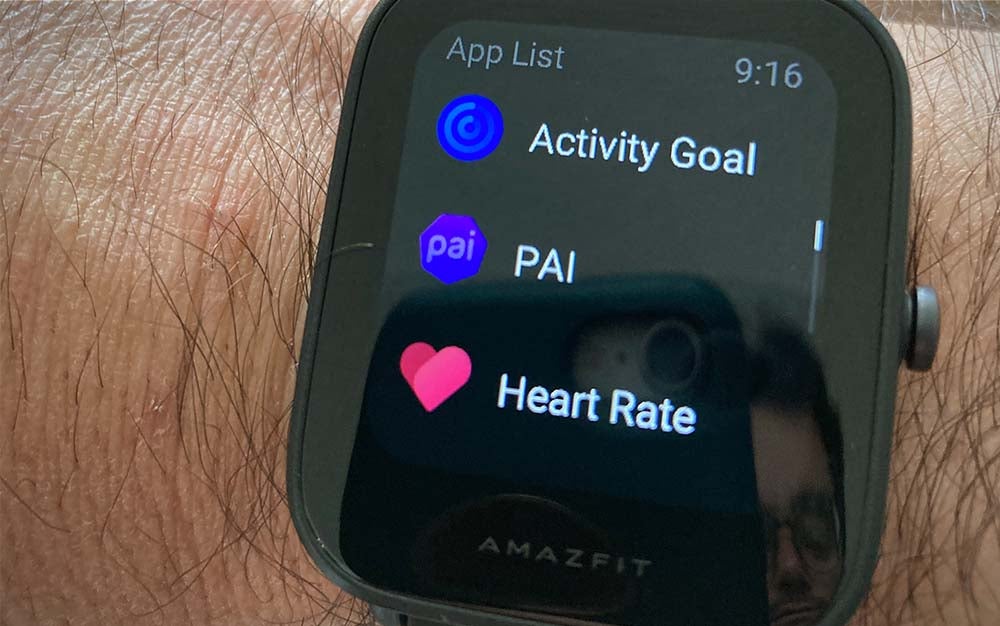
The Amazfit Bip Pro U fitness tracker delivered one measure that mattered most. It wasn’t my heart rate and blood oxygen levels, monitored by the BioTracker 2 PPG optical sensor. It also wasn’t my calories burned or steps taken (though I kept a close eye on both of these). It wasn’t even my sleep score factoring in how restless of a night I’d had based on the gyroscope reading. No, the score that most motivated me was PAI, or Personal Activity Intelligence—the personal physiological activity indicator. Based on my heart rate and daily activity intensity, the PAI score felt like the most accurate and comprehensive marker of my health. I found myself working harder to reach my daily score of 100—and raising my fist in triumph the moment the watch buzzed to tell me I’d reached the milestone. (OK, I also celebrated after crossing 10,000 steps to please the step tracker.)
The cool thing is that PAI is individualized based on your athletic ability and physical data, so not everyone needs to do the same amount of activity to reach 100 PAI. It also adjusts to your improved health, relying only on the previous seven days of data to set the activity level required to reach a maximum score. That means that as your health improves, it becomes harder to get to 100. The research behind PAI, based on 25 years of data, claims that reaching a score of 100 each day can decrease your risk of cardiovascular disease by 25 percent and increase life expectancy by an average of 5 years. But my wife thinks my main reason for liking PAI was that its data—measuring my activity, heart rate, breathing, and other factors—provides your current “health age.” I’m 34 in real life, but by the PAI count on my Zepp app, I’m a mere 26.
I also found myself compulsively checking my sleep score. Ironic, since with a newborn, my wife and I aren’t exactly sleeping well—or so I presumed. By measuring my breathing, movement, and positioning, the Amazfit smartwatch was able to track my sleep in detail, from the moment I passed out to the moment my 3-year-old crawled into bed at about 6:30 every morning. It even noted the minutes I woke up in the middle of the night to change a diaper or bounce my son back to sleep. With all that data, the Zepp app generated a color-coded chart telling me when I was in light sleep, deep sleep, REM sleep, or awake. From that, I was given a sleep score out of 100. Surprisingly, even with a newborn, I averaged 8 hours of sleep and scored an average of 83 points—though I did find it recorded that I had fallen asleep up to 30 minutes before I think I was truly out. My wife, who was exhausted from still bearing the brunt of middle-of-the-night feedings, was not as pleased with my solid sleep number. (She was also not pleased with the watch’s glow. About a week in, I smartened up and turned off the motion activation at night.)
The Amazfit Bip U Pro also regularly measures oxygen, stress, and breathing. It will periodically keep tabs on these markers to generate an average score, but you can also get a real-time measurement by clicking “measure” in the given subpage on the watch face and holding still while the sensors do their thing. The stress number, from 1 to 100, is based on heart rate variability, among other factors.
Fitness Tracker
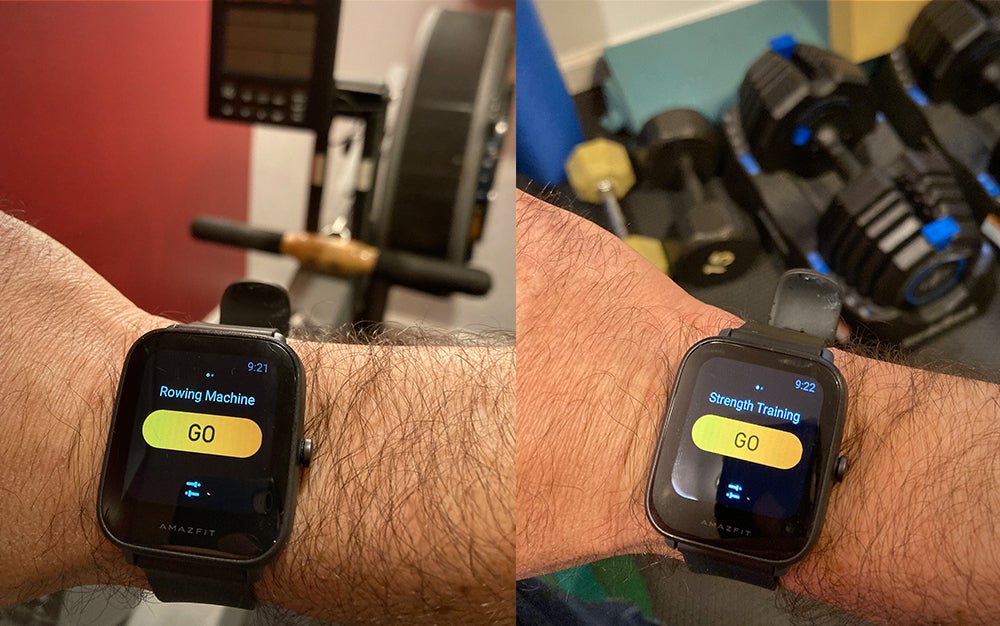
No matter how you get your exercise—even if it’s handball or fencing—the Amazfit Bip U Pro can track it. While 60 sport modes is definitely an impressive feature, there is not always huge variation between the modes. I tracked running, cycling, rowing, and strength training, and although there was certainly some difference in the data reported, the data wasn’t exactly revolutionary. For every workout, the smartwatch can track your exercise time, your average heart rate, and your calories burned. But with activities like weightlifting, that’s all you get. Other activities do get unique data. For instance, after I rowed I could view my total strokes and average stroke rates. And when cycling and running, the smartwatch’s GPS mapped my routes, while the accelerometer tracked my average pace (buzzing my watch with splits). The watch can also sync with your Strava app to get more detailed reports on your runs and rides. Plus, it’s water-resistant up to 50 meters, so you can swim laps, or take a cooling dip in the lake after your paddleboard session.
Connectivity
Pair the Amazfit Bip Pro U with your Android or Apple phone, and the smartwatch can buzz with every app notification or incoming call. I found it especially helpful to simply check my wrist while out jogging to quickly see if it was my wife calling or a spam call. The watch has a microphone for Alexa, but you can’t use it to answer calls. It was also fun to be at T-Mobile Park in Seattle and see the ESPN alert about a possible no-hitter at the Mariners game I was watching in person. The news alerts were perfectly readable on the LCD screen, though some emojis gave the watch trouble, appearing only as a rectangle with a question mark.
That built-in Alexa compatibility serves as a major selling point for the Amazfit Bip U Pro. And when the technology works, it’s really handy to use the smartwatch’s microphone to get basic answers. Swipe to the Alexa screen on the watch face, wait for the watch to buzz and for the screen to read “Alexa is listening,” and then ask your question. The answer will appear on the LCD screen, but if you’re looking for more than one sentence of information, you’re best off just using your phone or your smart speaker. One important note: After connecting to Alexa via the Zepp app by going to Profile>Add Accounts> Amazon Alexa, I regularly had trouble reconnecting, even on my home’s wireless, with the smartwatch alerting me that the network was busy.
Another useful connectivity feature should come as music to the ears of anyone who uses their phone to listen to tunes. When synced with your smartphone, you can use the watch to DJ, which is key when you’re on a bike ride and need to skip to a song with a faster beat to get you up that hill. One downside is that the Amazfit watch doesn’t store songs, and there’s no downloadable music app, so everything has to be done through your phone.
Who should buy the Amazfit Bip U Pro?
Billed as a first step into fitness tracking, the Amazfit Bip U Pro could very well be the last fitness tracker you ever need. For a budget smartwatch, it is nicely equipped, capable of recording everything from sleep and steps to stress levels, breathing, and blood oxygen levels. Built-in GPS and Alexa make it a really good bang for the buck.
Serious athletes might benefit from more detail in some of the workout reports, as well as a more svelte design and a band that doesn’t trap moisture. For such customers, the Fitbit Charge 4 might be the way to go. Meanwhile, customers looking for more downloadable apps and other true smartwatch features might very well want to budget for the Amazfit Bip U Pro’s more expensive doppelganger: an Apple Watch. Still, with 60 sport modes and useful alerts, this Amazfit smartwatch suits a wide audience—potentially helping more and more of us keep better track of our health.
Amazon
